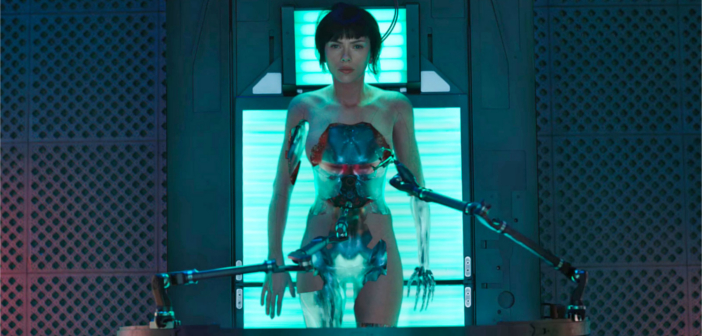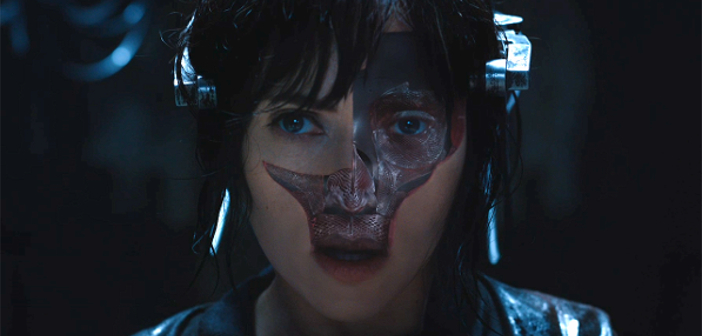Film Review | Ghost in the Shell 2017 Is Inferior, but Not Altogether a Bad Time
Released in 1995, Mamoru Oshii’s Ghost in the Shell had a huge impact on some of Hollywood’s more imaginative genre filmmakers, and is regarded today as one of the finest anime films ever made. It isn’t difficult to see why. The original Ghost manages to satisfy in a number of different registers: it is a futuristic sci-fi dystopia, an action film, a neo-noir mood piece and a searching examination of human identity in an age of rapidly evolving and encroaching technology.
The philosophical ambitions of the original manga are evident even the title. Artist Masamune Shirow borrowed it from Arthur Koestler’s book The Ghost in the Machine; the expression itself was a famous coinage of Gilbert Ryle to describe the Cartesian notion of an immaterial and free soul interacting with the deterministic matter of the human body. Ryle had no time for Cartesian dualism, of course, but his expression had a peculiar, unintentional poetic resonance. It seemed to describe the melancholy position of the human soul in a disenchanted and industrialized world.
These concerns fascinated the science fiction writer Philip K. Dick. His 1968 novel Do Androids Dream of Electric Sheep? was a searching examination of what it means to be human in a age where physical space is dominated by mass technology, and the human imagination has been colonized by the metaphor of the machine as a descriptor for its own nature. Where is the dividing line, if any exists, between human and machine, between the animate and inanimate? Do we become somehow less spontaneous, less empathetic, less human, through our constant interaction with technology? In Stanley Kubrick’s 2001: A Space Odyssey, the human crew of the space-ship come across as cold and affectless, the most human thing we witness is computer HAL’s increasingly poignant attempts to stave off its extinction. This was the future Dick predicted in Androids: a world where the machines are becoming more like people, and the people more like worn-out machines.

Dick’s reflections on the increasingly ghostly and fragile nature of human identity in the technological age reached the screen in Ridley Scott’s Bladerunner, and form the philosophical backdrop for Oshii’s two Ghost in the Shell movies (the sequel/companion piece Innocence was released in 2004). Central character ‘Major’ Motoko Kusanagi is a literal ghost in the shell: while her colleagues have only partially augmented human bodies, her identity (or ghost) is a cybernetic code animating a synthetic ‘full-body prosthesis.’ These movies explore the threat that technology might strip bare and mechanize the human spirit, alongside the possibility that the human spirit might instead enchant the world of mechanical artifice with a new kind of hybrid soul.
In 2017, these themes feel more pressing than ever: we now live in a world haunted by the idea of a post-human future, where algorithms predict our desires, eerie, fully-automated factories package them for delivery to our homes, and our physical lives become increasingly secondary to their translation into the fleeting nodes of the virtual economy. All this is to say that if if you’re looking for an updated exploration of the themes that run through PKD’s novels, Bladerunner and Oshii’s work, you won’t find it in Rupert Sanders’ new live-action Hollywood remake of Ghost in the Shell. The themes are there, of course, embedded as they are in the original story, but they find no sense of urgency in this new incarnation.
A quite conservative, risk-averse enterprise, Ghost in the Shell 2017 lives and breathes in the future shocks of yesterday, in the borrowed plumage of much loftier predecessors. In terms of theme and plot, it has little to do but shuffle through the maze of fabricated memories and fractured relationships between corporate Frankensteins and their castaway experiments which are now so familiar to us from Bladerunner and the original Ghost. There isn’t anything new being brought to the table here, and this was perhaps to be expected from a remake entrusted to a director who appears, at least on the face of it, far more a slick journeyman than a visionary of any kind. It wouldn’t be going too far to suggest that the new Ghost fillets away almost everything that made the original so distinctive and fascinating, leaving the shell of a far more routine sci-fi action film.
Now, all this may sound like I’m trashing the movie, but actually I have to admit I quite enjoyed it. The odds were always overwhelmingly against the remake coming anywhere within the ballpark of the original, in terms of originality, depth and cultural significance. Taken on its own terms, however, as a propulsive sci-fi blockbuster with a strong visual aesthetic and a magnetic lead, it isn’t half bad.

First, let’s look at the star. Scarlett Johansson has carved out a fascinating niche as a sci-fi muse in a sequence of movies that explore some of the post-human anxieties discussed in this review: in Her she played a Siri-like AI, in Lucy a woman who attains a kind of evolutionary apotheosis via accidental ingestion of a nootropic drug, and in Under the Skin an inscrutable alien occupying the body of a female human. It’s interesting to view her performance in Ghost in the Shell as a continuation of her work in Under the Skin; in both cases the character is fundamentally estranged from the skin in which they reside, and view their bodies as mysterious objects. Jesse Hassenger, writing for Brooklyn Magazine expresses it well: “There are few young actors more interesting to watch quietly grappling with what the hell it means to be human.”
(I don’t want to address the controversy surrounding Johansson’s casting in too much detail as that would require a article of its own. However, I think that if there was an Asian-American star with the same bankability as Johansson, I’m sure the producers would have considered casting her. Perhaps there should be an Asian-American actress with the same bankability as Scarlett, but I don’t think the producers can be blamed too much for acceding to the basic market necessity of having a bankable star to green-light a big-budget movie. Also, I’m not sure that the cultural back and forth going here is necessarily such a bad thing; the original Ghost takes a variety of Western influences – Philip K. Dick, Bladerunner, European philosophers – and makes something distinctly Japanese with them; now we have a Western blockbuster which is beholden to the distinct imagery, ambiance and kinetic movement of the manga and anime. This is how culture works: “love and theft,” in Bob Dylan’s expression.)
In stylistic terms, Ghost in the Shell is a triumph. The production design by Jan Roelfs (a frequent collaborator of Peter Greenaway many moons ago) is derivative, yes, but its rich, psychedelic sheen is light years away from the pedestrian uncanny valleys served up by most contemporary blockbusters. Sanders stages the action scenes with fleet dynamism and clarity, and has a strong eye for composition in the quieter moments. Many, of course, will carp that this is style over substance, but I think that the significance of style and form is often underestimated in cinema, and anyway – considering how many of our contemporary blockbusters have neither style nor substance, I’ll take what I can get. Ghost’s plot offers no surprises as I’ve said, but viewed a certain way, its economical storytelling has the unfussy charm of an old pair of shoes. At any rate, its refreshing to watch a action blockbuster that isn’t Phase 3 of some Nine Year Shared Universe Building franchise effort. Ghost in the Shell is likely to be a reliable punching bag for critics owing to its admitted inferiority to the original, but I found Scarlett Johansson’s continued exploration of post-human ennui, combined with the often beautiful technical qualities of the production, to make for an at least above average trip to the multiplex. So there.
Ghost in the Shell is in cinemas now. View the trailer below.
[arve url=”https://www.youtube.com/watch?v=G4VmJcZR0Yg” align=”center” maxwidth=”750"]

